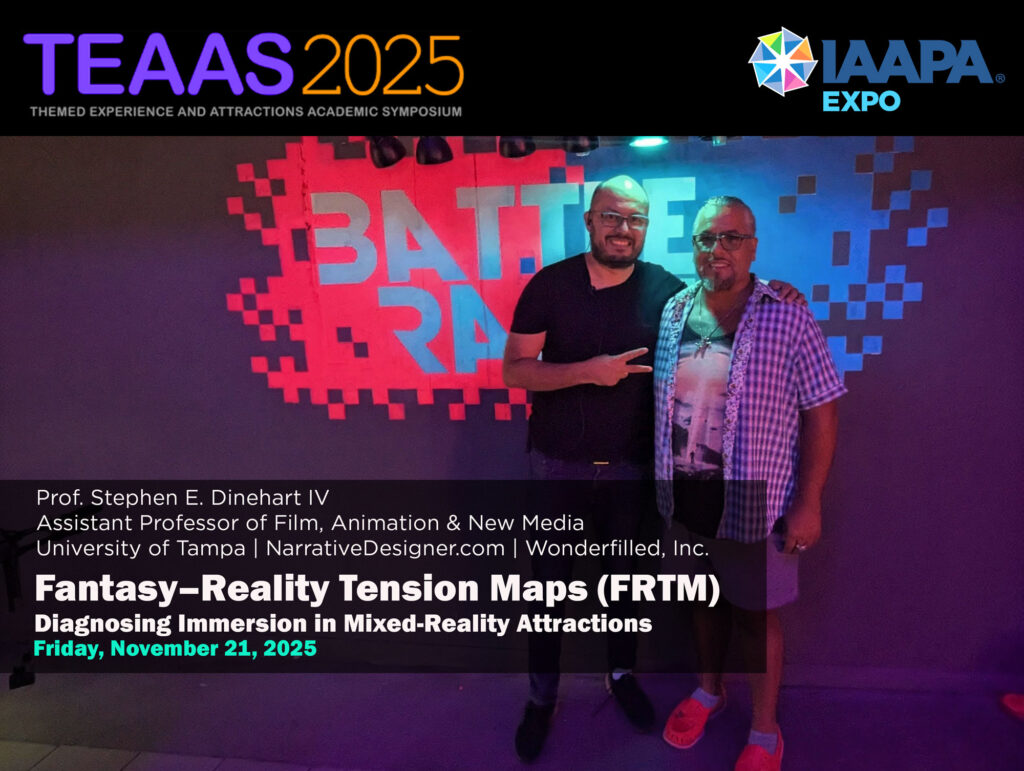
After two decades of working at the intersection of narrative design, interactive media, and themed entertainment, I'm excited to share a new research project that brings together everything I've learned about how perception, story, and technology create (or break) immersive experiences. I call it Fantasy–Reality Tension Maps (FRTM) — a diagnostic framework for identifying where immersion succeeds or fails in mixed-reality attractions.
The Problem
Theme parks are investing billions in mixed-reality experiences that blend physical environments with augmented reality, head-mounted displays, and interactive technology. But here's the challenge: every time you add a layer of technology between the guest and the story, you create potential "hotspots" where the fantasy can fracture.
A visible visor adjustment. A HUD element that reads as "interface" rather than "magic." A safety announcement that breaks the narrative flow. Each of these moments forces guests to toggle between belief in the story and awareness of the system.
The question isn't whether these tensions exist — they're inevitable in any mediated experience. The question is: How do we diagnose them, and how do we orchestrate them intentionally?
The Framework
FRTM maps three overlapping layers that govern immersive experiences:
Diegesis — The story world, theming, and narrative logic that shape guest expectations
Mediation — The technology and interfaces through which the story is perceived and enacted
Operational Reality — The safety protocols, throughput requirements, and staff procedures that keep attractions running
When these three layers align, guests experience what Csíkszentmihályi called "flow" — seamless immersion where action and awareness merge. When they diverge, you get hotspots: moments where operational necessity or technological limitation pierces the fiction.
The framework identifies three types of hotspots:
- Productive tensions that build anticipation or create gameplay challenge
- Neutral transitions that are necessary but forgettable
- Destructive breaks that shatter belief and pull guests out of the experience
By mapping where these hotspots occur along the guest journey — from queue through exit — designers can apply targeted interventions using what I call the five design patterns:
- Diegetic Covering — Embed operational necessities within story logic
- Latency Masking — Fill processing delays with synchronized sensory loops
- Parallel-Path Harmonization — Sync procedures with narrative pacing
- Interface Camouflage — Disguise technology as diegetic artifacts
- Exit-Arc Design — Extend narrative closure beyond the climax
The Research
This is ongoing research, and I'm presenting preliminary findings at TEAAS (Themed Entertainment Association Academic Symposium) at IAAPA in Orlando on Friday, November 22.
I've been studying two contemporary racing attractions that represent contrasting approaches to mixed-reality design:
Battle Racers (Miami) uses environmental AR — shared screens and projections that everyone sees together. The mediation is collective, which creates stable immersion through social reinforcement.
Mario Kart: Bowser's Challenge (Universal Epic Universe) uses personal AR — individual head-mounted visors that create a customized experience for each guest. The mediation is individualized, which enables incredible narrative density but introduces perceptual fragility.
I had the privilege of serving as show writer for Mario Kart during its development (2022-2024), and I've been conducting field observations at both attractions throughout 2025, including additional research this week in preparation for Friday's presentation.
Why This Matters
The goal of FRTM isn't to eliminate tension between fantasy and reality — it's to orchestrate it.
Some tensions are productive. The moment you put on the AR visor and the world transforms? That's a threshold transition that works because you're aware of crossing it. The challenge is distinguishing between tensions that enrich the experience and those that erode it.
As someone who coined the term "Narrative Designer" back in 2006, I've spent nearly two decades arguing that interactive narrative isn't just about telling stories — it's about designing systems where participants are both player and teller. We are all the Fabulator Ludus (a play on Huizinga's Homo Ludens) — the playing storyteller.
FRTM extends this thinking into the physical realm of themed attractions, where the "player-teller" is a guest moving through space, and the system includes not just software but architecture, operations, and live performance.
The Lineage
FRTM didn't appear out of nowhere. It's the culmination of a 24-year research arc:
- Forming Perception (2001) — My undergraduate thesis exploring how artists manipulate sensory experience to construct belief
- Transmedial Play (2006) — My USC thesis repositioning transmedia as a production methodology rather than just critical theory
- Narrative Designer: Fabulator Ludus (2010/2023) — Systematizing interactive narrative design as a discipline
- FRTM (2025) — Applying all of this to the challenge of diagnosing immersion in mixed-reality environments
What's Next
I'm treating this as living research. The findings I'm presenting Friday are preliminary — as these attractions mature and I expand the framework to other experience types, the methodology will evolve.
If you're interested in the full methodology, I've written a white paper that includes:
- Complete theoretical foundations
- Detailed case study analysis with hotspot tables
- The five design patterns with examples
- A practical FRTM application worksheet you can use on your own projects
- A glossary of key terms
[Download the white paper (PDF)]
I'd Love Your Feedback
This research exists at the intersection of game design, narrative theory, perceptual psychology, and themed entertainment operations. If you work in any of these fields — or you're just curious about how immersive experiences work — I'd love to hear your thoughts.
What hotspots have you noticed in attractions you've experienced? Where have you seen tensions orchestrated brilliantly? Where have you felt the "perceptual contract" shatter?
Drop a comment below or reach out directly: stephen.dinehart@ut.edu
And if you're at IAAPA this week, come find me Friday morning at the TEAAS poster session. Let's talk about how we diagnose magic.
Stephen E. Dinehart IV is Assistant Professor of Film, Animation & New Media at the University of Tampa. He pioneered the professional role "Narrative Designer" in 2006 and has contributed to AAA game titles, theme park attractions for Universal Creative, and transmedia storytelling theory.
